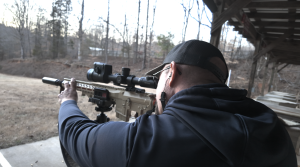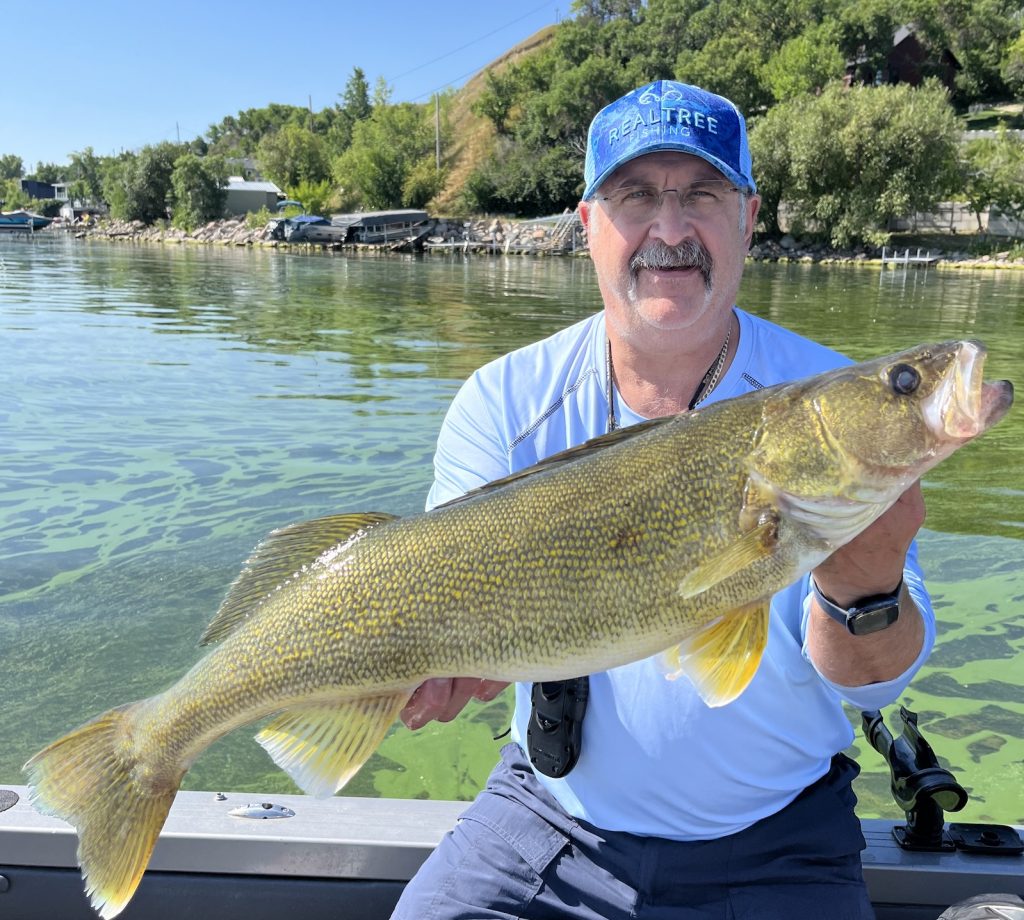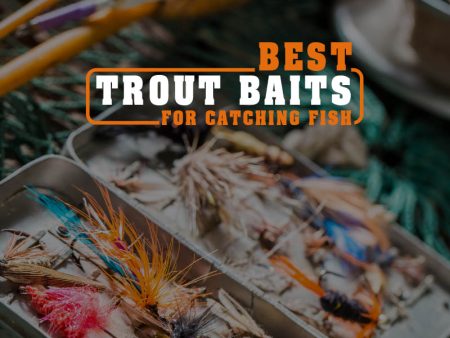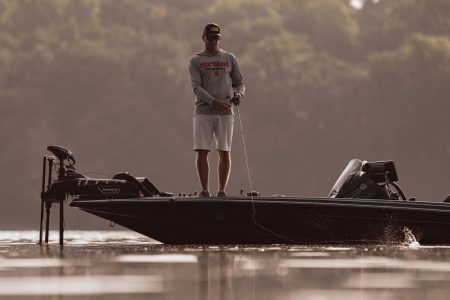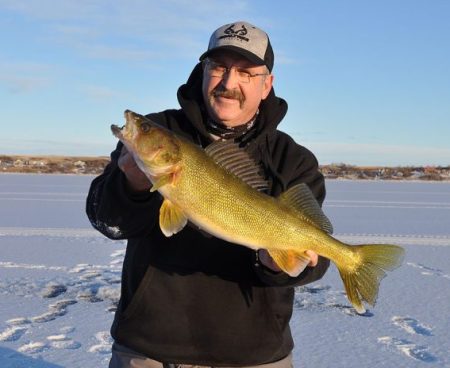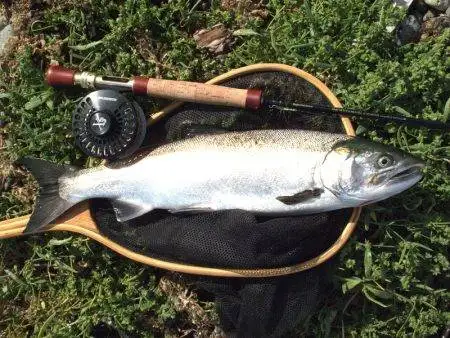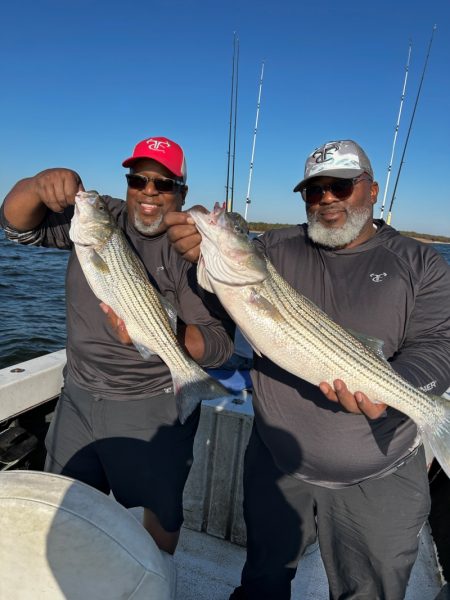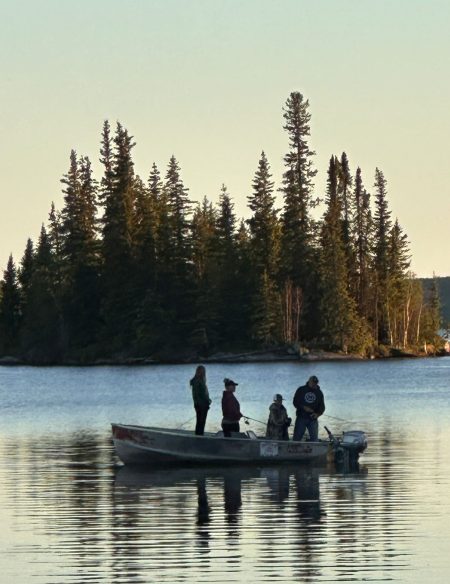During hot summer periods, walleye will leave their traditional shallow water spring structure feeding areas and move to other areas of the lake in search of food and optimal water temperatures. While some walleye will move into deeper water areas and spread out chasing bait fish along the thermocline, others will head straight to the weeds. Yes, I said weeds. Many years ago, I stumbled onto this weed pattern while on a mid-summer walleye fishing trip. Sadly, the wind was horrible and kept us off the water. Finally, on the last day of the trip, the wind died down just enough to allow us to launch a boat and do a little fishing in a sheltered bay where we thought we might catch a few small northern pike lurking in the weeds. It was that or another day of not fishing, so away we went.
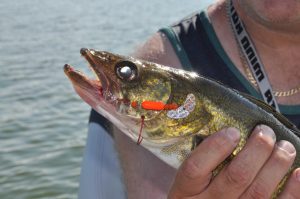
Once we started trolling, it didn’t take long before I chirped up, “fish on!” Instead of swimming away from the boat like pike so often do, this fish went straight under the boat and tried to stay there. As I brought the fish topside one of my buddies scooped up a nice walleye with the net. I thought this golden walleye was a bonus fish and a good way to start our outing. After the next couple of fish were walleye, we switched from pike gear to walleye gear. As the day unfolded, we trolled back and forth along a weed line in the bay and caught walleye after walleye! Since that day, I have fished for walleye in the weeds during the summer months and will continue to do so for years to come.
The Seasonal Movement To The Greens
In the spring and early summer, walleye are recovering from spawning and will search out crustaceans and bait fish lurking in the shallow and warmer areas of the lake. During this time frame, weed beds are basically nonexistent so these little creatures take cover around structure such as rip rap, rocky areas, along points and even spread out over large sand flats where they tuck away in the ridges, low spots and around humps in the sand. However, as the summer progresses and other areas of the lake start to warm up, weed beds start to grow and flourish. As areas of the lake grow green, the small aquatic creatures start to move off structure and hang out in the weeds.
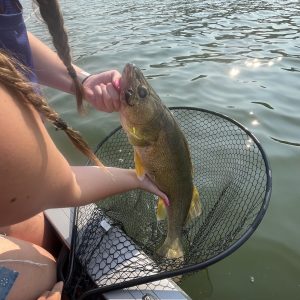
Without much food remaining in the shallow water areas, the walleye will disburse in search of food. Some walleye head to deeper water and spend the summer feeding on bigger fish such as cisco. Other walleye will move to the weeds to spend the summer munching on minnows, perch, and small aquatic creatures. When the walleye follow their food source into the weeds, they also find cover, protection, and shade.
Weed beds are not static like rock piles. As the season unfolds, they will change in both shape and size. This means the outer edge of a weed bed will move, and the shape of the weed bed may change. Also, weed beds are not solid masses of green. There are actually countless pockets of open spaces, weeds of different heights, and shaded areas within the greenery. As the sun moves through the day, weed beds will also create shady areas that move and change throughout each day.
Walleye thrive under these conditions and use these mazes of cover, shade and openings to their advantage as they swim amongst the weeds in search of a quick meal. When they are not feeding, walleye hold in the weeds and find reprieve from larger predators, the strong summer sun and often the activities of recreational boaters who avoid boating in and around weeds. With that said, walleye are savage predators, so even when they are at rest, they will not turn down the opportunity to dart out and inhale an unsuspecting minnow or crustacean as it swims by them.
When Walleye Fishing, Not All Greens Are Equal
Remember that not all weeds are equal when looking for weed areas to fish. Broadleaf weeds such as cabbage weed generally hold more walleye than narrow leaf weeds. Submergent weeds will typically hold more walleye than floating weeds. Established weed beds will hold more walleye than newly emerging weed beds. Weed beds that are adjacent to deep-water areas will usually have more walleye than weed beds in extremely shallow water. As well, areas, where two or more types of weeds are growing, will often hold more walleye than areas with just one type of weed.
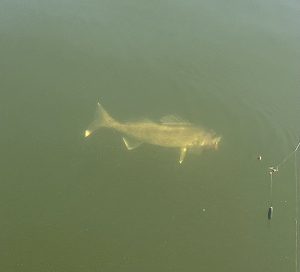
Weeds typically grow in the same areas year after year. When looking for weed beds, don’t just focus your search on weeds growing adjacent to shorelines. Also, look for mid-lake weed areas that may be growing on a muddy lake bottom, on a hump, or on the edge of a ledge.
Sometimes you can stumble upon weeds by simply trolling and getting snagged on the weeds below. However, there are better and quicker ways to find the weeds. Look at maps of the lakes you plan to fish and seek out areas that may be conducive to growing weeds. Then, visit those areas with your boat and use your electronics to pick out weed beds. Often you can pick out weeds using conventional sonar. You can also find weeds using side images, forward-facing sonar, or with an underwater camera.
Once you find the weeds, try to determine the size and shape of the weed bed, its height, how thick the weeds are, and where there are open pockets to help you figure out the best fishing presentation for that weed bed. I like to make notes on my phone about various weed beds, as I find such areas can be fished for the entire summer and often year after year.
Successful Fishing, Let’s Get Vertical!
One of my favorite presentations to fish weed beds is to use a slip bobber suspending a small single hook or a jig tipped with a lively leech or live minnow (where legal). The offering can be cast so that the bait is suspended along the outer edges of a weed bed, in the openings amongst the weeds, or over shorter weed growth areas. The wiggling action of the bait will entice walleye to dart from their hiding spots in the weeds and gulp in the bait and hook. As soon as the bobber goes down, set the hook and start reeling in to prevent the walleye from getting too far into the weeds and getting tangled up.
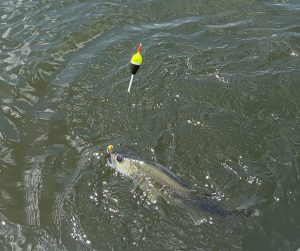
When fishing with slip bobbers, try using a two-to-three-foot lighter weight line as a leader below a small swivel attached to your heavier main line. Should your lure get tangled in the weeds and can’t be pulled free, the lighter line will break off and the swivel will save your bobber from floating away and potentially getting lost. Adding a small bead between the swivel and your bobber will protect the knot from the bobber when reeling in fish.
If slip bobber action seems too slow or isn’t pulling fish out of the weeds, try anchoring directly above or along the edge of a weed bed and do some vertical jigging. Jig heads, jigging spoons, blade baits and lipless crank baits work best. The flash, sounds and action of these lures moving up and down is more aggressive than the motion of a suspended live bait and may be just what it takes to make a walleye lurking in the weeds lunge out and strike.
Walleye will often take a lure as it flutters downwards. Therefore, when vertically jigging, it is imperative to stay in contact with the lure at all times. While the lure is dropping, watch the line to see if it moves sideways or stops moving. If it does either, set the hook because a walleye has probably just grabbed the lure. When walleye are really aggressive, they will chase upwards and strike a rising lure. In these cases, the fish is already moving upwards, so a strong follow-through is required on these hook sets.
Check out this assortment of Vertical Jigs
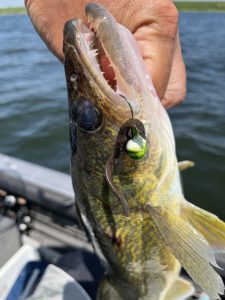
Similar to ice fishing, when tipping jigs or jigging spoons for vertical jigging over the weeds, use only a small piece of bait, such as a minnow head or fish eye (where legal). Doing so adds scent to the offering while not changing the action of the lure. It also reduces the chances of getting snagged in the weeds, which helps the bait stay on the hook. On hot summer days, keeping minnow heads fresh can be tough, so another option is to add a small scented plastic to the lure.
Another option for vertical jigging in and around weed beds is the use of blade baits and small lipless crank baits like the PK Lures Ridge Rattl’r. When using this style of lure do not use any bait at all and let the natural action of the lures attract fish. If you want to add some scent to these styles of lures, apply some gel style fish attracting scent like Pro-Cure Trophy Walleye Super Gel.
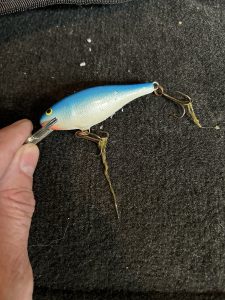
Horizontal Bait Presentations
You can also fish weed beds horizontally. Trolling a spinner rig or crankbait along the outer edges of the weed bed is an excellent tactic to entice walleye lurking in the cover to dart out and grab your offering. Always make sure to also troll along the shady edges of the weed beds as often active walleye will be working the shadows.
When trolling along the edge of a weed bed, try and get as close to the edge as you can. Sure, you might get caught up in the weeds occasionally, but the reward will be worth it, as walleye will dart out of the weeds to grab your lure.
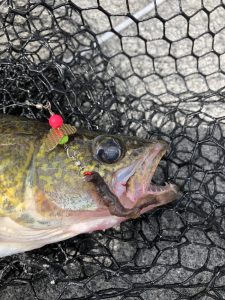
When using spinner blades along weed edges, try to use the most giant baits you can. In these situations, big, lively leeches and long earth crawlers will produce the best results. Upsizing the size of your blades is also a good idea, as the bigger blades will produce more flash and vibrations than smaller blades. The use of floats on spinner rigs will help the rig ride a little higher off the bottom, which can reduce snags and make your offering more visible.
Crankbaits can also be trolled just above the tips of submerged weed beds. However, doing so is a game of inches. Crank baits pulled just above the tips of the weed beds won’t get snagged in the weeds, but will trigger strikes from walleye in the weeds. However, if the bait is pulled too high above the weeds it won’t trigger strikes. And, if the crankbaits are run too deep, they’ll continually get hung up in the weeds.
On bright sunny days, natural baitfish patterns are my go-to colors. On cloudy days or when fishing in water churned up by waves, bright fluorescent colored crank baits are the way to go.
Use Bass tactics to catch Walleye in the Weeds
Early in the season, when the weeds are starting to grow, try casting specialty weedless jigs with scented plastics, as these lures will easily cut through the weeds. The idea is to cast into pockets of weeds and hop them back to the boat. Always let the jig drop through the weeds so it hits bottom. As the jig drops, the plastic bait will flutter and attract walleye. Once the jig bottoms out, pause briefly, jerk the jig forward, reel in a little slack line, and then let the jig drop. Keep repeating, and be ready to set the hook when you feel any pressure on your line. In most cases, the strikes with this presentation will be very aggressive.
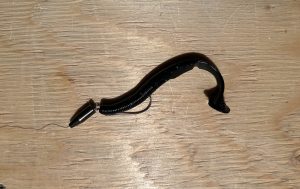
When fishing for walleye during late summer, the weeds often become very thick and difficult to penetrate with a jig and an artificial bait. Under these circumstances, it’s time to toss Texas rigs. To tie a Texas Rig, slide a bullet sinker and then a bead onto your fishing line. Then tie on a 2/0 or 3/0 Texas rig hook and attach a scented worm, ensuring the tip of the hook is embedded in the worm and not sticking out of the bait.
The beauty of the Texas Rig is that it can be cast into even the thickest of weeds and not get hung up. As the rig drops, keep your line tight so you can feel any bites. Also, watch your line, as strikes on these rigs are often very subtle. Once the lure bottoms out, keep working it back to the boat, similar to how the weedless jigs are retrieved.
Final Thoughts – Walleye Fishing in the Weeds
While fishing for walleye in the weeds can be highly productive, it can also prove to be very frustrating. Snags and hookups on the weeds can and do occur. To reduce frustration and reduce the number of lures lost in the weeds, try upgrading the fishing line from the usual 4 to 8-pound test line typically used for walleye fishing to the 12 to 14-pound test. That way, snagged lures can be yanked out of the weeds, hopefully without breaking the fishing line. I use Berkley Trilene Extra Tough fishing line over braided line when fishing in the weeds. I do so because this line is abrasion resistant and will typically break off at the knot when the lure can’t be pulled out of the weeds and needs to be broken off, whereas braided line will need to be cut as it generally doesn’t break off.
Per our affiliate disclosure, we may earn revenue from the products available on this page.

